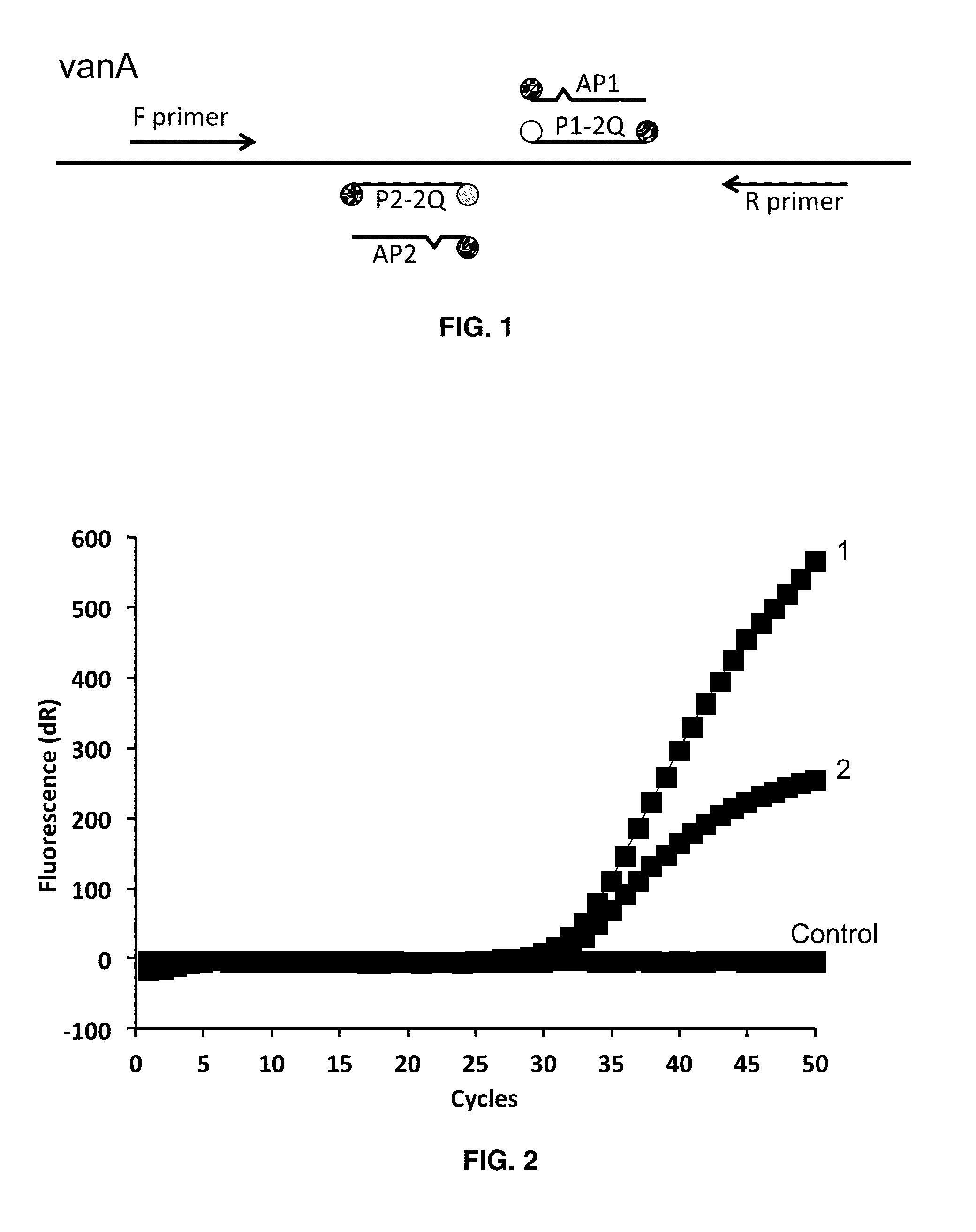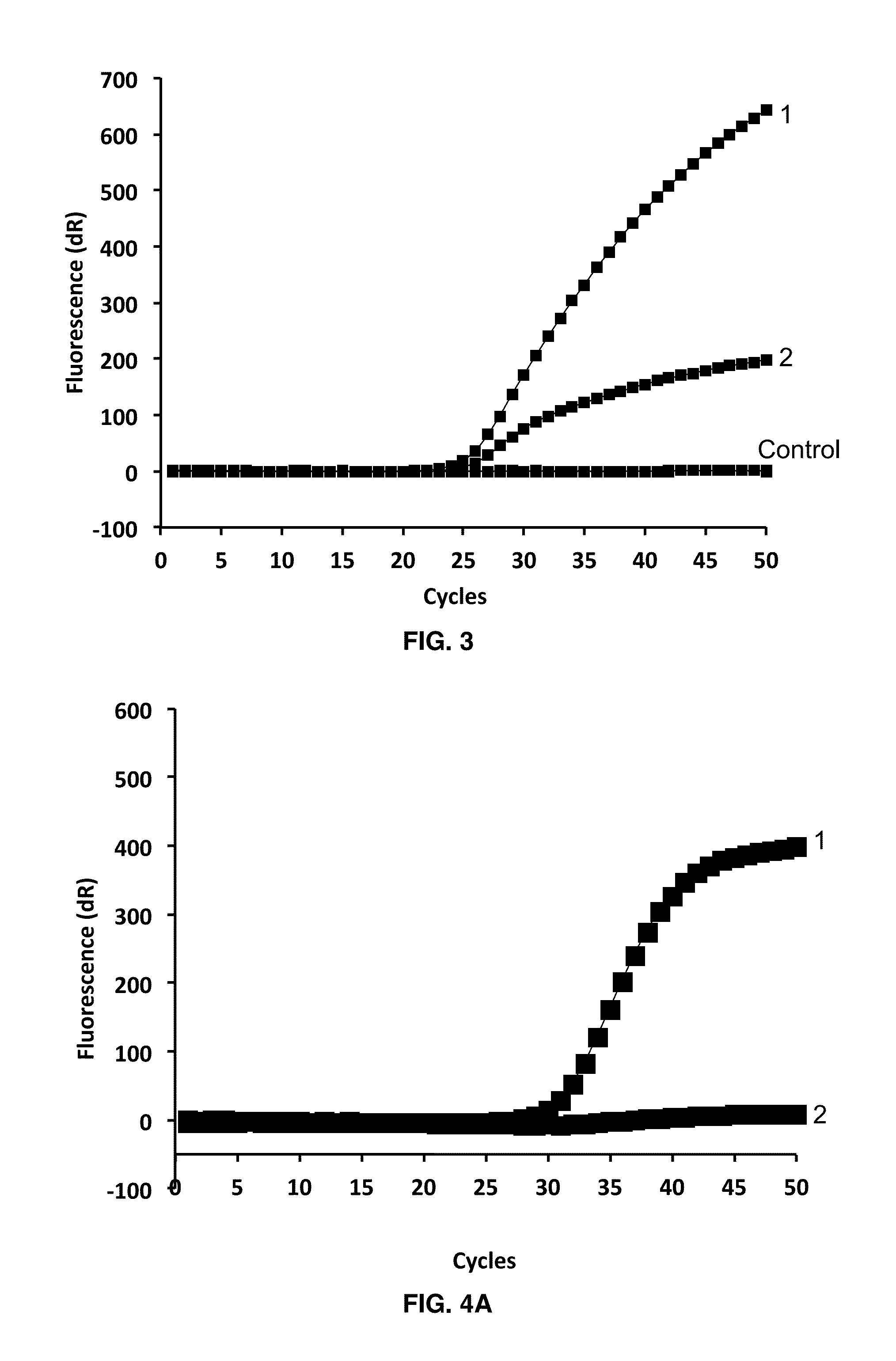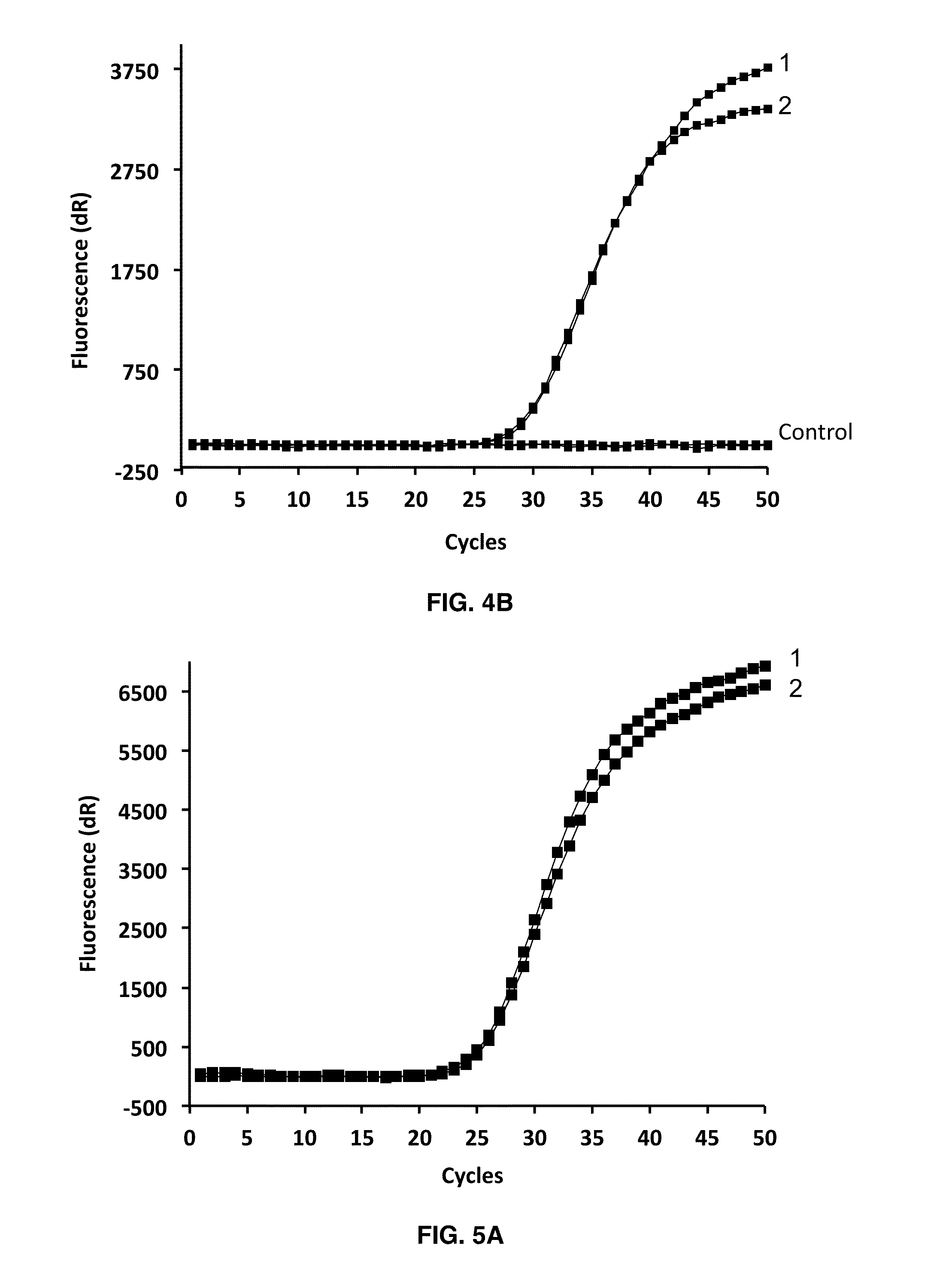Dual Probe:Antiprobe Compositions for DNA and RNA Detection
a technology of antiprobe composition and dna detection, applied in the field of nucleic acid probe technology, can solve the problems of difficult design or development of dual probe composition, difficult synthesis of dual probe, and high cost of conventional dual-labeled probes, so as to improve signaling and/or reliability, improve signaling and improve the effect of reliability in detecting the targ
- Summary
- Abstract
- Description
- Claims
- Application Information
AI Technical Summary
Benefits of technology
Problems solved by technology
Method used
Image
Examples
example 1
Real-time PCR Using iDDS Probes for the Detection of Vancomycin A (VA)-resistant Enterococcus (vanA VRE)
[0100]Each tube contained either an ULTRAMER® oligonucleotide template comprising the targeted vanA gene segment, or DNA extracted from clinical samples. The probes, antiprobes, and primers were fabricated with the following sequences and labeling, and were used at the indicated final concentrations:
VA probe 1:(SEQ ID NO: 1)FAM-CTCCCGCCTTTTGGGTTATTAA-BHQ-1at 200 nM,VA antiprobe 1:(SEQ ID NO: 2)TTAATAACCCAAATGGCGGGAG-BHQ-1at 150 nM,VA probe 2:(SEQ ID NO: 3)CFR610-CGCAACGATGTATGTCAACGA-BHQ-2at 200 nM,VA antiprobe 2:(SEQ ID NO: 4)TCGTTGACATACCTCGTTGCG-BHQ-2at 150 nM,VA forward primer:(SEQ ID NO: 5)GATATTCAAAGCTCAGCAATTTGTat 300 nM,andVA reverse primer:(SEQ ID NO: 6)TAGCTGCCACCGGCCTAat 300 nM.
[0101]Cycling conditions: Real-time PCR was performed with an Mx3005p instrument (Stratagene, Inc.) using HOTSTART-IT PROBE® qPCR master mix (USB, Inc.) (2×) supplemented with 1 μl of 25 mM MgCl2...
example 3
Real-time PCR Using iDDS Probes for the Detection of Trichomonas vaginalis (T. vag.) Repetitive DNA
[0106]Each tube contained either an ULTRAMER® oligonucleotide template comprising the targeted T. vaginalis gene segment, or DNA extracted from clinical samples. The probes, antiprobes, and primers were fabricated with the following sequences and labeling, and were used at the indicated final concentrations:
T. vag. probe 1:(SEQ ID NO: 13)TET-CCTCGGAGTCTTTGAATCGG-BHQ-2at 200 nM,T. vag. antiprobe 1:(SEQ ID NO: 14)CCGATTCATAGACTCCGAGG-BHQ-2at 100 nM,T. vag. probe 2:(SEQ ID NO: 15)ROX-ACCAAGAATGGTGTAACTCGACCT-BHQ-2at 200 nM,T. vag. antiprobe 2:(SEQ ID NO: 16)AGGTAGAGTTACACCATTCTTGGT-BHQ-2at 100 nM,T. vag. forward primer:(SEQ ID NO: 17)AATTTCCGTTTAATTTCATGGTCat 300 nM,andT. vag. reverse primer:(SEQ ID NO: 18)TTYGTGTCTCGTGCCATAGTCat 300 nM.
[0107]Cycling conditions: Real-time PCR was performed as described in Example 1, except that 50 cycles of 2-step PCR were generally performed. The qPCR re...
example 5
Real-time PCR Using iDDS Probes for the Detection of a Deletion in Exon 19 (D19) of the Human Epidermal Growth Factor Receptor (EGFR) Gene
[0111]Each tube contained an ULTRAMER® oligonucleotide template comprising the targeted EGFR gene segment. The probes, antiprobes, and primers were fabricated with the following sequences and labeling, and were used at the indicated final concentrations:
D19 probe 1:(SEQ ID NO: 25)Q670-CTCTGGATCCCAGAAGGTGAGA-BHQ-2at 200 nM,D19 antiprobe 1:(SEQ ID NO: 26)TCTCTCCTTCTGGGATCCAGAG-BHQ-2at 400 nM,D19 probe 2:(SEQ ID NO: 27)FAM-CAAGGAATTAAGAGAAGCAACATCat 200 nM,D19 antiprobe 2:(SEQ ID NO: 28)GATGTTGCCTCTCTTAATTCCTTG-BHQ-1at 400 nM,D19 forward primer:(SEQ ID NO: 29)GGTAACATCCACCCAGATCAat 200 nM,andD19 reverse primer:(SEQ ID NO: 30)CATCGAGGATTTCCTTGTTGat 200 nM.
[0112]Cycling conditions: Real-time PCR was performed as described in Example 1 except that 50 cycles of 2-step PCR were performed, using an annealing / extension step at 54° C. for 1 min. The results ...
PUM
| Property | Measurement | Unit |
|---|---|---|
| real time PCR | aaaaa | aaaaa |
| transfer of fluorescent energy | aaaaa | aaaaa |
| fluorescence emission spectrum | aaaaa | aaaaa |
Abstract
Description
Claims
Application Information
 Login to View More
Login to View More - R&D
- Intellectual Property
- Life Sciences
- Materials
- Tech Scout
- Unparalleled Data Quality
- Higher Quality Content
- 60% Fewer Hallucinations
Browse by: Latest US Patents, China's latest patents, Technical Efficacy Thesaurus, Application Domain, Technology Topic, Popular Technical Reports.
© 2025 PatSnap. All rights reserved.Legal|Privacy policy|Modern Slavery Act Transparency Statement|Sitemap|About US| Contact US: help@patsnap.com



